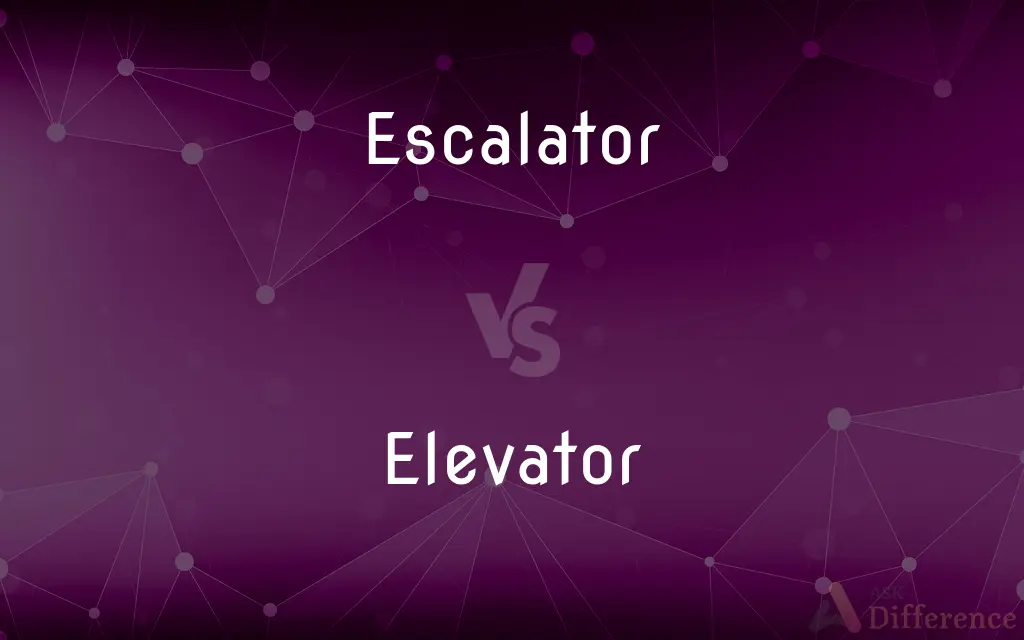Escalator vs. Elevator — What's the Difference?
By Tayyaba Rehman — Updated on November 6, 2023
An escalator is a moving staircase for transporting people between floors, whereas an elevator is a compartment in a shaft that moves vertically.

Difference Between Escalator and Elevator
Table of Contents
ADVERTISEMENT
Key Differences
Escalators are continuously moving mechanical staircases designed to transport people between floors of a building. They are often found in public places like shopping malls, airports, and subway stations. Elevators, or lifts, are enclosed cabins that move people or goods vertically within a building's shaft.
An escalator provides a convenient way to move large numbers of people between a few floors without waiting. Elevators are essential in high-rise buildings for efficient vertical transportation over several floors. Both escalators and elevators are integral to modern infrastructure, enabling easy access across different levels of a structure.
Maintenance for escalators involves keeping the mechanical steps in constant motion and ensuring safety mechanisms are functional. Elevators require regular inspections of cables, pulleys, and electrical systems to ensure safe operation. Escalators offer an open-concept transit between floors, while elevators provide a private and secure space during transit.
Safety features for escalators include emergency stop buttons and comb plates to prevent items from getting caught. Elevators are equipped with alarms, emergency lights, and in some cases, phones or intercom systems for safety and communication. Escalators cater to a steady flow of foot traffic, whereas elevators can control the flow with operating schedules or keycard access.
Despite serving a similar purpose in transporting people, escalators and elevators differ in design, operation, and suitable applications. Escalators are best for short vertical distances and high-traffic areas, while elevators are suited for greater heights and diverse uses including freight.
ADVERTISEMENT
Comparison Chart
Movement
Continuous loop, moving steps.
Vertical, cabin moves up and down.
Operation
Open, no waiting period.
Enclosed, may require waiting.
Capacity
Designed for mass transit.
Limited by cabin size.
Floors Served
Shorter vertical distances.
Can serve many floors.
Space
Requires less space than an elevator.
Can be restricted due to shaft size.
Compare with Definitions
Escalator
A set of moving steps for upward or downward transportation.
The escalator was out of service, so they had to use the stairs.
Elevator
A lift for transporting people vertically within a building.
The office building's elevator system was recently modernized.
Escalator
A conveyor transport device for people, consisting of individual, linked steps.
He stood to the right on the escalator, allowing others to pass on the left.
Elevator
A cage or box that moves vertically in a shaft to transport people or freight.
They loaded the furniture into the freight elevator.
Escalator
A moving staircase for carrying people between floors.
They took the escalator to the second floor of the mall.
Elevator
A vertical transport equipment that moves people between building levels.
The elevator dinged as it arrived on the fifth floor.
Escalator
An electrically powered moving stairway to transport individuals between floors.
The museum's escalator is a spiral, offering views of the entire atrium.
Elevator
An elevator (North American English) or lift (Commonwealth English) is a type of cable-assisted, hydraulic cylinder-assisted, or roller-track assisted machine that vertically transports people or freight between floors, levels, or decks of a building, vessel, or other structure. They are typically powered by electric motors that drive traction cables and counterweight systems such as a hoist, although some pump hydraulic fluid to raise a cylindrical piston like a jack.
Escalator
A moving staircase that helps in the easy ascend or descend between building levels.
The children were fascinated by the escalator at the train station.
Elevator
A platform or an enclosure raised and lowered in a vertical shaft to transport people or freight.
Escalator
An escalator is a moving staircase which carries people between floors of a building or structure. It consists of a motor-driven chain of individually linked steps on a track which cycle on a pair of tracks which keep them horizontal.
Elevator
The enclosure or platform with its operating equipment, motor, cables, and accessories.
Escalator
A moving staircase consisting of an endlessly circulating belt of steps driven by a motor, which conveys people between the floors of a public building.
Elevator
A movable control surface, usually attached to the horizontal stabilizer of an aircraft, that is used to produce motion up or down.
Escalator
A moving stairway consisting of steps attached to a continuously circulating belt.
Elevator
A mechanism, often with buckets or scoops attached to a conveyor, used for hoisting materials.
Escalator
An escalator clause.
Elevator
See grain elevator.
Escalator
Anything that escalates.
Elevator
Anything that raises or uplifts.
Escalator
A motor-driven mechanical device consisting of a continuous loop of steps that automatically conveys people from one floor to another.
There is a plastic molly-guard covering the escalator's shutdown button to prevent little kids from pushing it and stopping the escalator.
Elevator
A permanent construction with a built-in platform or cab that can be raised and lowered, used to transport people and goods, as between different floors of a building.
Escalator
An upward or progressive course.
Elevator
A silo used for storing wheat, corn or other grain (grain elevator).
Escalator
An escalator clause.
They agreed to a cost-of-living escalator.
Elevator
(aeronautics) A control surface of an aircraft responsible for controlling the pitching motion of the machine.
Escalator
A stairway or incline arranged like an endless belt so that the steps or treads ascend or descend continuously, and one stepping upon it is carried up or down; - originally a trade term, which has become the generic name for such devices. Such devices are in common use in large retail establishments such as department stores, and in public buildings having a heavy traffic of persons between adjacent floors.
Elevator
A dental instrument used to pry up ("elevate") teeth in difficult extractions, or depressed portions of bone.
Escalator
A clause in a contract that provides for an increase or a decrease in wages or prices or benefits etc. depending on certain conditions (as a change in the cost of living index)
Elevator
(anatomy) Any muscle that serves to raise a part of the body, such as the leg or the eye.
Escalator
A stairway whose steps move continuously on a circulating belt
Elevator
A type of shoe having an insert lift to make the wearer appear taller.
Elevator
One who, or that which, raises or lifts up anything.
Elevator
A mechanical contrivance, usually an endless belt or chain with a series of scoops or buckets, for transferring grain to an upper loft for storage.
Elevator
A cage or platform (called an elevator car) and the hoisting machinery in a hotel, warehouse, mine, etc., for conveying persons, goods, etc., to or from different floors or levels; - called in England a lift; the cage or platform itself.
Elevator
A building for elevating, storing, and discharging, grain.
Elevator
A muscle which serves to raise a part of the body, as the leg or the eye.
Elevator
An instrument for raising a depressed portion of a bone.
Elevator
A movable plane or group of planes used to control the altitude or fore-and-aft poise or inclination of an airship or flying machine.
Elevator
Lifting device consisting of a platform or cage that is raised and lowered mechanically in a vertical shaft in order to move people from one floor to another in a building
Elevator
The airfoil on the tailplane of an aircraft that makes it ascend or descend
Elevator
A platform or compartment for raising or lowering people or goods between floors.
She pressed the button to call the elevator to the lobby.
Elevator
An enclosed cabin in a shaft, moving vertically to carry passengers or cargo.
The glass elevator provided a panoramic view of the city.
Common Curiosities
How do escalators work?
Escalators work by a system of motors and chains moving a set of revolving steps in a loop.
Can elevators be used in case of fire?
Typically, elevators should not be used in case of fire due to safety concerns.
Are escalators safe for children?
Yes, when used properly under adult supervision, escalators are safe for children.
What is the weight capacity of an elevator?
The weight capacity varies by design but is typically posted inside the elevator cabin.
Can escalators be ridden in both directions?
No, escalators are usually fixed to move in one direction, up or down.
What is an escalator?
An escalator is a moving staircase to transport people between floors of a building.
What is an elevator?
An elevator is a cabin in a vertical shaft that moves people or goods between floors.
How are escalators maintained?
Regular inspections and maintenance are required to ensure their safe operation.
Can elevators operate during a power outage?
Some elevators can operate on emergency power or have a backup system.
Do elevators have emergency systems?
Yes, elevators are equipped with emergency alarms, lights, and sometimes communication devices.
What types of buildings use elevators?
Elevators are used in residential, commercial, and industrial buildings.
What happens if an escalator breaks down?
If an escalator breaks down, it stops moving and can be used as regular stairs.
Are there different types of elevators?
Yes, there are passenger, service, and freight elevators, among others.
Can wheelchairs go on escalators?
Wheelchairs should not be used on escalators; elevators are the safer option.
Is there a maximum height for escalators?
There's no strict maximum, but practical design limits are usually around 60 feet.
Share Your Discovery

Previous Comparison
Present vs. Gift
Next Comparison
Northbound vs. SouthboundAuthor Spotlight
Written by
Tayyaba RehmanTayyaba Rehman is a distinguished writer, currently serving as a primary contributor to askdifference.com. As a researcher in semantics and etymology, Tayyaba's passion for the complexity of languages and their distinctions has found a perfect home on the platform. Tayyaba delves into the intricacies of language, distinguishing between commonly confused words and phrases, thereby providing clarity for readers worldwide.















































